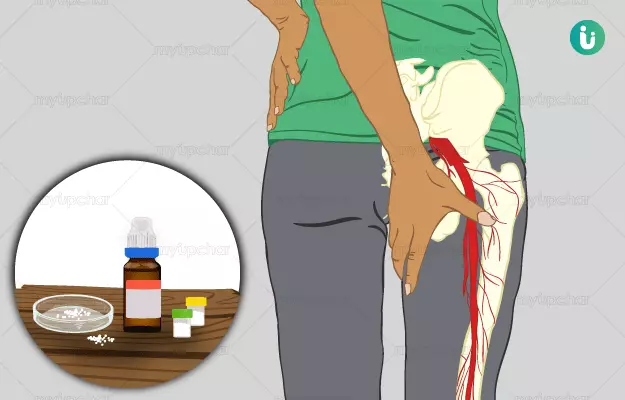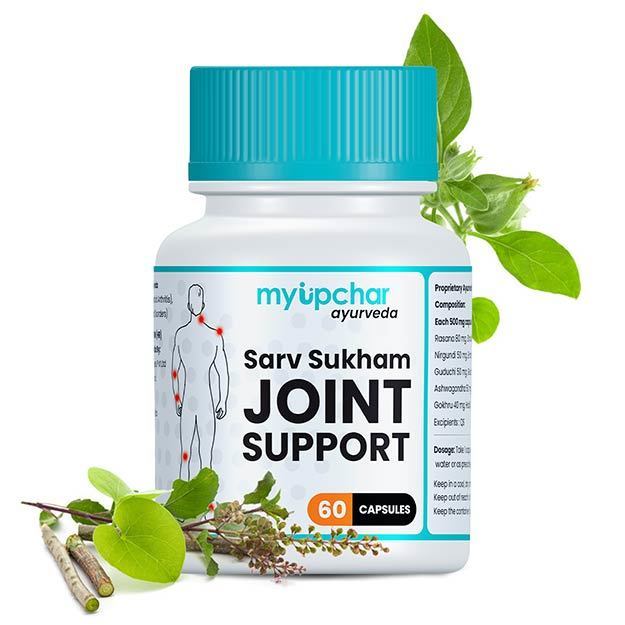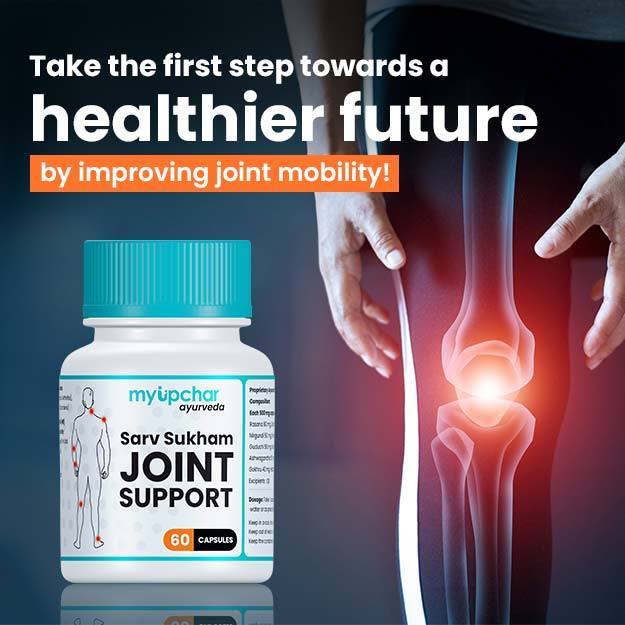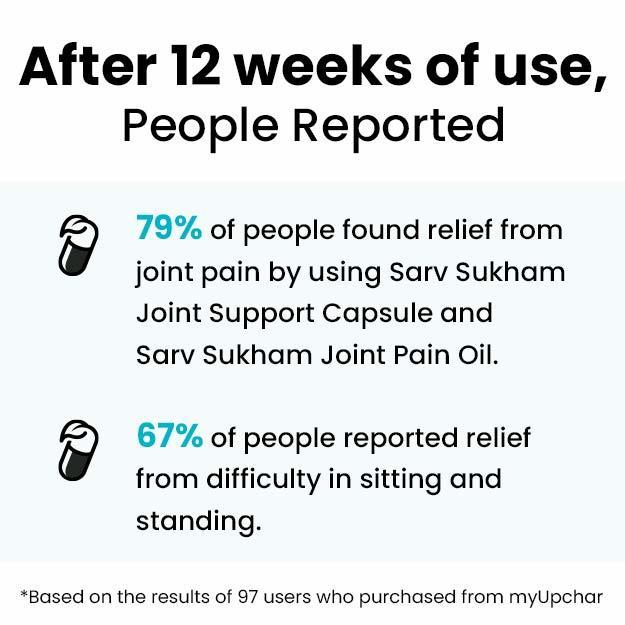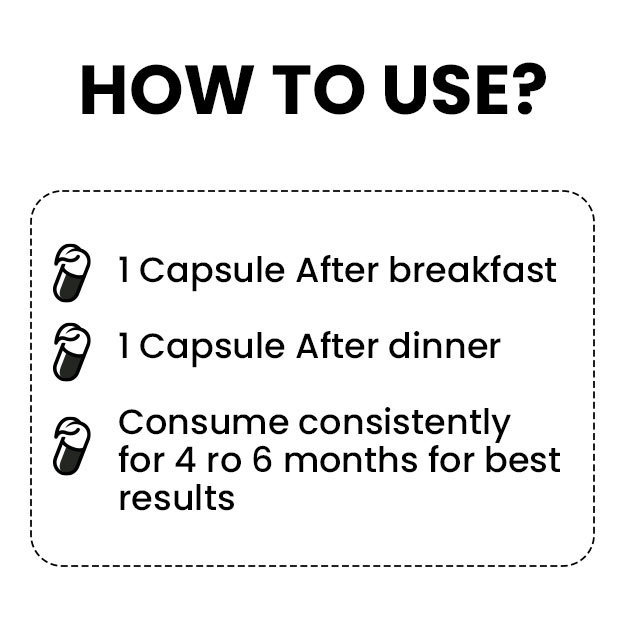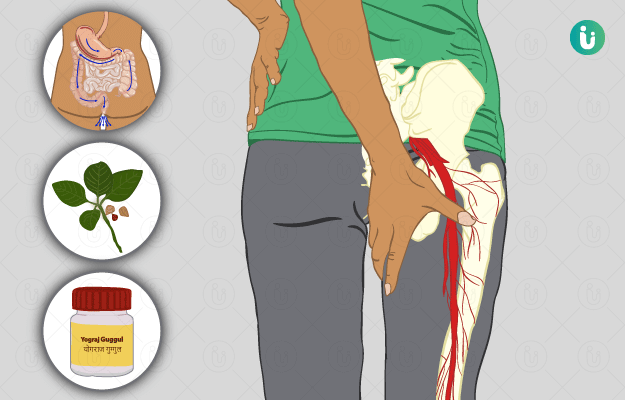Sciatica refers to a pain that occurs due to the compression of the sciatic nerve roots (initial portion of the sciatic nerve) in the lower back. Sciatica pain typically starts suddenly and travels down the back to the outer side or front of the leg (along the path of the sciatic nerve). The pain is described as shooting and usually affects only one side. It may be associated with neurologic symptoms such as numbness, tingling and weakness in various parts of the affected leg and foot. Activities like lifting heavy objects may trigger sciatica. Pressure on the sciatic nerve anywhere along its course when a disc is pushed out of place (herniated disc), lumbar spinal stenosis (narrowing of the spinal canal in the lower back), spondylolisthesis (forward slip of the disc over the vertebrae below it), tumour within the spine, infection that affects the spine or injury to the spine are also some causes linked to sciatica. Common risk factors of sciatica include age, occupation, sedentary lifestyle and hormones related to pregnancy.
Conventionally, sciatica is treated with pain killers, physiotherapy and lifestyle management, surgery is done in extreme cases when the pain does not subside and causes major discomfort to the patient.
Homeopathic treatment works on improving the overall health of the person instead. Homeopathic medicines help control the pain during sciatica attacks, prevent the recurrence of attacks, reduce stiffness and improve joint mobility. They also help slow down the progression of the disease and work on reducing the chances of relapse.
Homeopathic medicines along with physiotherapy can bring significant relief to the patient’s condition, especially in mild to moderate cases. Common remedies employed by a homeopathic physician to treat sciatica are belladonna, colchicum autumnale, phytolacca decandra, plumbum metallicum and rhus toxicodendron.
Acute and rheumatic cases of sciatica are treated with drugs like aconitum napellus and bryonia alba, while chronic cases of sciatica can be treated using arsenicum album, calcarea carbonica, phosphorus, plumbum and rhus toxicodendron. Homeopathic remedies also aid in promoting post-surgical recovery.
- Homeopathic medicines for sciatica
- Dietary and lifestyle changes for a sciatica patient as per homeopathy
- How effective are homeopathic medicines and treatments for sciatica
- Side effects and risks of homeopathic medicine and treatments for sciatica
- Takeaway
Homeopathic medicines for sciatica
- Aconitum Napellus
Common Name: Monkshood
Symptoms: Monkshood is mainly given to restless individuals (both physically and mentally), who don't want to be touched and have anxiety. Other symptoms that indicate a need for this drug are:- Stiffness in back along with pain
- Tingling sensation along with numbness in the back; the person feels that their back is bruised
- Shooting pain in legs and arms
Symptoms worsen on lying down on the affected side, in the evening and night, and in dry and cold winds while they improve when the person spends time in open air.
- Ammonium Muriaticum
Common Name: Sal ammoniac
Symptoms: Symptoms that call for treatment with this remedy include:- A bruising type of pain in the tailbone on sitting
- Back pain on sitting; the person feels as if their back is held tightly from both sides
All complaints get better in open air.
- Belladonna
Common Name: Deadly nightshade
Symptoms: Belladonna acts on every part of the nervous system. It is indicated for congestion, pain and twitching that occur due to inflammation. Symptoms associated with sciatica that may be treated using this remedy are:- Intense painful pressure on the back
- Lumbago (Pain in the muscles and joints of the lower back) accompanied by pain in the hips and thighs
- Shooting pain in extremities
Symptoms worsen in the afternoon, on lying down, and on touching the affected site. Symptoms improve when the person sits in a semi-erect position.
- Chamomilla
Common Name: German chamomile
Symptoms: Chamomilla is well suited for irritable and sensitive patients who experience the following symptoms:- Unbearable pain in the hips and loins
- Lumbago
Symptoms aggravate at night, when the person gets angry or goes out in open air and they improve in warm and humid weather.
- Colchicum Autumnale
Common Name: Meadow saffron
Symptoms: Colchicum affects the muscles and bones, specifically the periosteum (a dense layer of tissue that envelops the bones), and synovial membranes of joints. Symptoms that call for treatment with this remedy are:- Pain in the lower back
- Back pain that gets better on applying pressure on the affected site and on taking sufficient rest
- Weakness and tingling in limbs
Symptoms worsen from dawn till dusk, on moving the affected limb, lack of sleep, and with mental exertion, whereas they get better on stooping.
- Gnaphalium Polycephalum
Common Name: Cud-weed, old bals
Symptoms: Gnaphalium polycephalum is highly beneficial for sciatica patients, especially those who also experience numbness along with pain in the affected part. Other symptoms that call for treatment with this remedy are:- Chronic pain in lower back, which subsides on getting sufficient rest
- Lumbago with heaviness in the pelvic area
- Natrium Sulphuricum
Common Name: Sulphate of sodium, Glauber's salt
Symptoms: This is a remedy primarily acts on the liver and nervous system. Symptoms that indicate a need for this remedy are:- Piercing pain between the shoulder blades
- Itching in the back on undressing
- Spinal meningitis with opisthotonos (spasm of the muscles causing backward arching of the head, neck and spine)
- Pain in the hip joint and limbs
Symptoms worsen on lying on the left side, and in humid conditions. The person gets temporary relief in dry weather and on applying pressure on the affected area. Symptoms also improve on changing positions.
- Phytolacca Decandra
Common Name: Poke-root
Symptoms: This remedy helps alleviate the following symptoms:- Lower back pain
- Radiating pain in spine that travel up and down into the sacrum (a triangular bone at the base of the lower back)
- Stiffness in back on getting up in the morning, especially in humid weather
- Pain in the backside of thighs
Symptoms worsen on exposure to cold and rainy weather, on moving about and on lying on the right side. Symptoms improve in dry weather, on applying warmth on the affected area and after taking sufficient rest.
- Plumbum Metallicum
Common Name: Lead
Symptoms: Symptoms that can be relieved with this remedy are:- Spinal cord sclerosis
- Lightning-like pains in the back; the person gets temporary relief on applying pressure on the affected site
- Numbness and tingling sensations in extremeties
- Paralysis of legs
Symptoms worsen at night and on moving, and get better with on applying pressure on the affected area and with physical exertion.
- Rhus Toxicodendron
Common Name: Poison-ivy
Symptoms: This remedy is usually recommended in case of rheumatic pain, and affections of the skin and mucous membrane. Other symptoms that indicate a need for this remedy are:- Pain and stiffness in the lumbar region that get better on sitting, moving about or on lying on a hard surface
- Stiffness of extremities
Symptoms worsen at night, in cold and rainy weather, and when the patient lies on their back or on the right side. Symptoms improve in dry and warm weather, on walking or stretching limbs, and on applying warmth on the affected area.
- Ruta Graveolens
Common Name: Rue, bitterwort
Symptoms: This remedy helps manage the following symptoms:- Pain in the back that reduces on applying pressure on the affected site
- Lumbago that aggravates in early morning
- Pain in thigh on stretching the affected leg
Symptoms worsen in cold weather and on lying down.
- Tellurium Metallicum
Common Name: The metal tellurium
Symptoms: Tellurium metallicum is mainly indicated for symptoms associated with the eye, ear and spine. Patients who benefit from this remedy have the following symptoms::- Sensitive backbone
- Pain in the sacrum
- Sciatica, which worsens on coughing and straining and on lying on the right side
- Contracture of tendons in the back of the knee joint
Symptoms worsen at night, in cold weather, with friction or on touching the affected area.
Dietary and lifestyle changes for a sciatica patient as per homeopathy
Homeopathy is a holistic mode of treatment. It focusses on improving the overall health of the individual rather than just working on symptomatic management. Also, homeopathic remedies are administered in highly diluted doses and their action can get easily affected by several dietary and lifestyle factors. Thus, homeopathic doctors suggest their patients include the following changes in their everyday life:
Do’s:
- Engage in recreational activities.
- Include some physical activities like brisk walking and light labour in your daily routine.
- Consume nutritious food and drinks.
- Keep your surroundings clean.
Don’ts:
- Avoid coffee, Chinese and other herbal teas, stimulants and alcohol that is prepared with vegetable substances or spices.
- Avoid all kinds of strong-smelling water and perfumes.
- Avoid spicy food, sauces, cakes, chocolates, crude medicinal vegetables for soups and dishes made of herbs, roots and stalks of plants that possess medicinal properties.
- Avoid consumption of onions, old cheese, celery, and meat, which may be stale or possess medicinal qualities.
- Do not consume meat such as the flesh and fat of ducks or geese.
- Avoid all excess in food and the use of excess sugar, salt and stimulant beverages.
- Stay away from strong-scented flowers and avoid tooth powders and essences.
- Avoid tight-fitting or uncomfortable clothes.
- Avoid a sedentary lifestyle.
How effective are homeopathic medicines and treatments for sciatica
Homeopathy has been successful in the treatment of nerve-related pains, including acute and chronic sciatica.
In a single-blind placebo study, 35 patients with sciatica were treated with individualised medicines and then followed up for a month after their recovery. All patients experienced some relief from symptoms indicating that homeopathic medicines work more than just placebos.
An observational study published in the Clinical Journal of Pain indicated the efficiency of homeopathic medicine in the treatment of pain. For the study, 129 adults with chronic low back pain, who were treated by 48 different homeopathic physicians, were followed up for 2 years. All patients showed a marked reduction in the use of conventional medicines and an improvement in their health and quality of life.
Side effects and risks of homeopathic medicine and treatments for sciatica
It is globally accepted that homeopathic remedies rarely cause adverse effects, though patients who take homeoapthic treatment often experience an aggravation of symptoms before a desirable effect is seen.
In an explorative study done in Norway, seven homeopathic physicians were interviewed to ask their views on these temporary adverse effects of homeopathic medicines and whether these should be considered as side effects. It was noted that there was a disagreement among the participants whether homeopathic remedies produced side effects, but they agreed on the fact that if an incorrect remedy was administered, it may cause disruptive or suppressive reactions in the patient. This was not identified as adverse effects, but as a possibility to prescribe a new remedy.
Homeopathic remedies are made using extremely diluted natural substances and thus are said to be safe to use for infants, pregnant and lactating women and adults. However, it is best that you refer to a physician before taking any medicine on your own.
Takeaway
Sciatica refers to a pain in the lower back that radiates down the leg along the sciatic nerve. Conventional treatment of sciatica involves painkillers, physiotherapy and surgery. Along with pain reduction, homeopathic treatment of sciatica aims at improving overall health of the person and preventing relapse of the disease. Homeopathic medications are potentised and prescribed in minute doses. They have an excellent tolerability profile with negligible side effects. Sciatica can be easily managed using homeopathic remedies, when the medicines are taken under the guidance and supervision of a qualified homeopathic practitioner.
Find Homeopathic Doctor in cities
Doctors for Homeopathic medicine, treatment and remedies for Sciatica

Dr. Rutvik Nakrani
Homeopathy
6 Years of Experience

Dr. Jyothi
Homeopathy
23 Years of Experience

Dr. Urvashi Chaudhary
Homeopathy
8 Years of Experience

Dr. Anita Kumari
Homeopathy
12 Years of Experience
References
- Orthoinfo [internet]. American Academy of Orthopaedic Surgeons, Rosemont IL. Sciatica.
- Oscar E. Boericke. Repertory . Médi-T; [lnternet]
- Witt CM, Lüdtke R, Baur R, Willich SN et al. Homeopathic treatment of patients with chronic low back pain: A prospective observational study with 2 years' follow-up. 2009 May;25(4):334-9. PMID: 19590483
- Wenda Brewster O’Reilly. Organon of the Medical art by Wenda Brewster O’Reilly. B jain; New Delhi
- Trine Stub, Terje Alræk, Anita Salamonsen et al. The Red flag! risk assessment among medical homeopaths in Norway: a qualitative study. 2012 Sep 11. PMID: 22967054
- MedlinePlus Medical Encyclopedia: US National Library of Medicine; Sciatica
- Pramanik Supriya, Sharma Pawan. Sciatica: Its miasmatic analysis & Homoeopathic treatment. Conference: International Convention on World Homoeopathic Day 2016. New Delhi, India.

